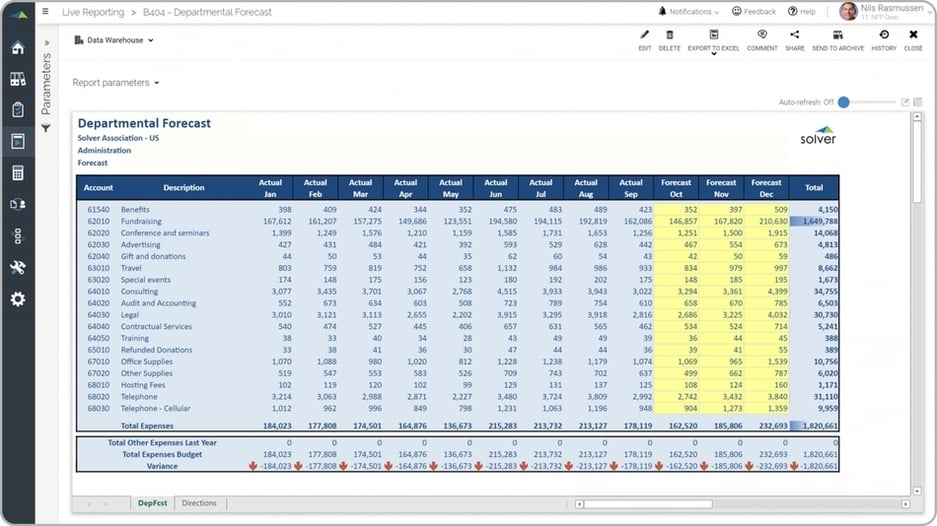Related Posts
BLOG HOME
- Top 50 Opportunities Report for SaaS Companies using Dynamics 365 BC
- Subscription Sales by Contract Length Report for SaaS Companies using Dynamics 365 Business Central
- Lead Target Model for SaaS Companies using Dynamics 365 Business Central
- Cap Table Template for SaaS Companies using Dynamics 365 Business Central
- Rolling 12 Month Cash Balance Report for SaaS Companies using Dynamics 365 Business Central
Department Expense Forecast for Nonprofit Organizations
What is a Department Expense Forecast for Nonprofit Organizations? Expense Forecast input templates are considered forecasting tools and are often used by budget managers and department heads to generate a bottom-up estimate for the remainder of the year. Key functionality in this type of input template retrieves year-to-date actual data for the chosen department and then provides input for the remaining periods of the year. You will find an example of such an input template below.
Purpose of Department Forecast Models Organizations use Department Forecast Models to automate the forecasting process through secure, web-based data entry forms. When used as part of good business practices in a Financial Planning & Analysis (FP&A) department, a nonprofit can improve its planning speed and capabilities, and also provide a full year estimate to support the annual budget process. It will also reduce the chances that a forecasting process takes too much time from department managers and their other responsibilities.
Department Forecast Model Example Here is an example of a web-based Forecasting Model for expenses.
 Who Uses This Type of Input Template? The typical users of this type of input template are: Budget managers and department heads. Other Input Templates Often Used in Conjunction with Department Forecast Models Progressive Financial Planning & Analysis (FP&A) Departments sometimes use several different Department Forecast Models, along with annual budget models with payroll detail, reports, dashboards and other management and control tools.
Who Uses This Type of Input Template? The typical users of this type of input template are: Budget managers and department heads. Other Input Templates Often Used in Conjunction with Department Forecast Models Progressive Financial Planning & Analysis (FP&A) Departments sometimes use several different Department Forecast Models, along with annual budget models with payroll detail, reports, dashboards and other management and control tools.
Where Does the Data for Analysis Originate From? The Actual (historical transactions) data typically comes from enterprise resource planning (ERP) systems like: Microsoft Dynamics 365 (D365) Finance, Microsoft Dynamics 365 Business Central (D365 BC), Microsoft Dynamics AX, Microsoft Dynamics NAV, Microsoft Dynamics GP, Microsoft Dynamics SL, Sage Intacct, Sage 100, Sage 300, Sage 500, Sage X3, SAP Business One, SAP ByDesign, Acumatica, Netsuite and others. In analyses where budgets or forecasts are used, the planning data most often originates from in-house Excel spreadsheet models or from professional corporate performance management (CPM/EPM) solutions.
What Tools are Typically used for Reporting, Planning and Dashboards? Examples of business software used with the data and ERPs mentioned above are:
Purpose of Department Forecast Models Organizations use Department Forecast Models to automate the forecasting process through secure, web-based data entry forms. When used as part of good business practices in a Financial Planning & Analysis (FP&A) department, a nonprofit can improve its planning speed and capabilities, and also provide a full year estimate to support the annual budget process. It will also reduce the chances that a forecasting process takes too much time from department managers and their other responsibilities.
Department Forecast Model Example Here is an example of a web-based Forecasting Model for expenses.
 Who Uses This Type of Input Template? The typical users of this type of input template are: Budget managers and department heads. Other Input Templates Often Used in Conjunction with Department Forecast Models Progressive Financial Planning & Analysis (FP&A) Departments sometimes use several different Department Forecast Models, along with annual budget models with payroll detail, reports, dashboards and other management and control tools.
Who Uses This Type of Input Template? The typical users of this type of input template are: Budget managers and department heads. Other Input Templates Often Used in Conjunction with Department Forecast Models Progressive Financial Planning & Analysis (FP&A) Departments sometimes use several different Department Forecast Models, along with annual budget models with payroll detail, reports, dashboards and other management and control tools. Where Does the Data for Analysis Originate From? The Actual (historical transactions) data typically comes from enterprise resource planning (ERP) systems like: Microsoft Dynamics 365 (D365) Finance, Microsoft Dynamics 365 Business Central (D365 BC), Microsoft Dynamics AX, Microsoft Dynamics NAV, Microsoft Dynamics GP, Microsoft Dynamics SL, Sage Intacct, Sage 100, Sage 300, Sage 500, Sage X3, SAP Business One, SAP ByDesign, Acumatica, Netsuite and others. In analyses where budgets or forecasts are used, the planning data most often originates from in-house Excel spreadsheet models or from professional corporate performance management (CPM/EPM) solutions.
What Tools are Typically used for Reporting, Planning and Dashboards? Examples of business software used with the data and ERPs mentioned above are:
- Native ERP report writers and query tools
- Spreadsheets (for example Microsoft Excel)
- Corporate Performance Management (CPM) tools (for example Solver)
- Dashboards (for example Microsoft Power BI and Tableau)
To learn more, visit the Resource Library.
Global Headquarters
Solver, Inc.
Phone: +1 (310) 691-5300
Information
Solver Suite
Core Subscription
Company and Resources
Global Headquarters
Information
Solver Suite
Core Subscription
Company and Resources
Global Headquarters
Information
Solver Suite
Core Subscription
Company and Resources
Global Headquarters
Information
Solver Suite
Core Subscription
Company and Resources
